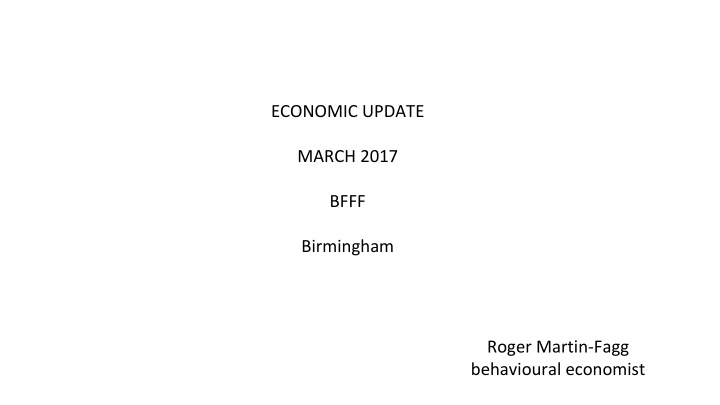



ECONOMIC UPDATE MARCH 2017 BFFF Birmingham Roger Martin-Fagg behavioural economist
Mainstream vv Behavioural Economists Economic man Emotional man Rational Instinctive 20% 80% System 2 System 1 Daniel Kahneman Thinking fast, Thinking slow 2011
80% of the time humans make choices based on System 1. ANCHORING: we use the first bit of information to make subsequent judgements RULE OF THUMB: a rough and ready workable approach based on little or no information CONFIRMATION BIAS: we seek out information which confirms our beliefs. 2/3 of Americans obtain their news from social media; Facebook, WhatsApp and Twitter create groups of like minded people which leads to herding.
Brexit Trump Italian referendum French President Dutch elections in March All the consequence of system 1 thinking
THE DEFINITION OF VALUE ADDED SALES REVENUE subtract ALL PAID INVOICES = + PROFIT AFTER TAX WAGES AND SALARIES AND INTEREST This is Nominal Gross Domestic Product (GDP) 50-90% produced by businesses employing fewer than 200 people in most countries. Circa 57% in UK.
Since 1982 in the UK the share of wages in added has fallen by 4 percentage points
Share of wages fell 5 percentage points in the USA
SHORT RUN ECONOMIC ACTIVITY is driven by the flow of spending multiplied by VELOCITY = MONEY NOMINAL GDP X 95% manufactured Determined by interest rates, the media, by commercial the weather, house prices but above all banks CONFIDENCE Banks manufacture money when they make a loan(bank credit)and can destroy money when a loan is paid down.
70% of the World economy is enjoying strong monetary growth with rising velocity Charts show country share of Global GDP
UK broad money growth consistent with 2.4% growth in GDP and 3% inflation end 2017 16 Bank of England
UK trade with the EU as a % of total trade
The UK current account
The balance of trade in goods with biggest trade partners November 2016
The goods and services trade deficit is around 36Bn pa The primary income is the net of dividends and rents received and paid from abroad, salaries repatriated deficit 18Bn pa The secondary income is transfers e.g. o’seas aid(£12Bn) pensions and winter fuel allowance to Spain membership of the EU(£13Bn), military bases abroad etc deficit 25Bn We need around 79Bn financing pa
44% of UK financial exports are to the EU 35% of all insurance exports are to the EU Passporting rights will be replaced by equivalence: the EU will grant free access if the regulation in the country of origin is deemed of equal standard Our banking rules our tougher than the EU and solvency 2(insurance capital adequacy) is a global standard It will take a lot of time to agree but should be granted
The pensions budget is £156 bn, 21% of Govt spend and rising rapidly
The UK: big bulge of oldies over next 20 years: we need more young workers
COIB forecast 224,000 new recruits needed over next 3 years 40% of London construction labour force is from o’seas
this maintains our workforce 2016
Both the EU and the UK are close to trend growth 2.4%pa 1.7%pa
Mortgage approvals for house purchase and housing transactions picked up in November and December 2016 DEC Sources: Bank of England and HM Revenue and Customs. (a) Number of residential property transactions for values of £40,000 or above.
The situation at the beginning of 2017 The UK purchasing power has dropped 20% 30% of our GDP is spent on imports Every 10% fall in sterling adds 1% to core inflation within 18 months Input prices now increasing by 20% Consumers are having a fling ( final?) in anticipation of higher inflation, higher interest rates,lower growth
The Economic reality of the UK Since 1985 our balance of payments deficit has been financed by stable long term inward investment, 50% from EU companies If this investment falls away the following will happen: weak pound higher inflation decline in affordability house prices fall recession
Real wages decline end 2017 but consumer unlikely to react until Q2 2018 due to the ‘money illusion’ 17 18
UK Real GDP Scenarios per 4% annum 3% 2.5% FREE TRADE DEAL 2% WTO inflation and interest rates rise above expectations deal 1% end 2018 2016 2017 2018 2019 2020 2013 2014 2015 2021 -1%
It has always been America First
Exchange rates next 2 years Weak Euro, Strong Dollar Sterling? Depends on negotiations Difficult=weaken Going well=strengthen Averages for next 2 years. £-$ 1.25 £-Euro 1.20
Conclusion Currently the economy is performing well because the EU, USA, China, India, Japan are expanding But expect a slow down beginning mid-2018 Recession or no recession will depend on the value of sterling weaker sterling=less growth Long run interest rates up 1% by 2018 and Bank rate will follow The Prime Minister cannot control markets nor the attitude of 27 EU member states
Retail sales volume YOY Expect 3.5% average for 2017
CPI inflation likely to be 3.0% end 2017 Nominal GDP ( the value of sales) will grow by 5% Real growth will be 2% House prices will grow 3-5%
Over the next few years you should look carefully at your business model Even if there is a slow down, labour supply will be a growing problem ( weak sterling makes UK unattractive for EU workers, the EU is growing more strongly, and the vote to leave implies unwelcome) The only solution is more automation: this must be your focus of attention
Recommend
More recommend